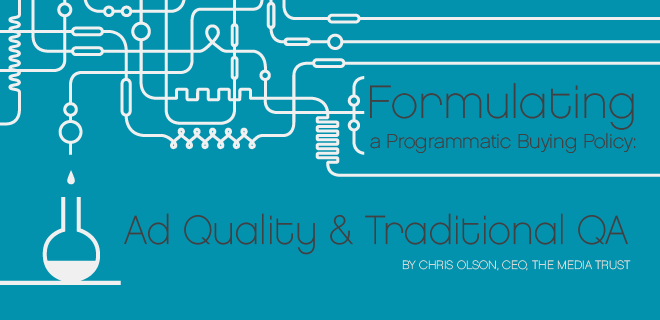
Making the dive into programmatic buying can be daunting, but a lot less so when fortified policies are in place. Below is an amalgam of how aggressive Media Trust clients in particular address ad quality and data leakage issues, split into four quality segments.
- Ad Security
- Data Security
- Ad Quality – Brand safety and channel conflict management
- Traditional QA – Ad types, technical specification rules, site performance
3. Ad Quality – Brand Safety and Channel Conflict Management
A few items to think about before putting pen to paper to write your policy:
- Nothing replaces being able to see ads to verify that unwanted creative are not running on the site.
- You will want to establish parameters with your exchanges and validate that their buy-side and network partners have the means to quickly enforce compliance if a bad ad gets through.
- Make sure that all ads that are making it to your site have been checked and accurately categorized prior to winding up there.
Your policy choices here are fairly flexible. Many publishers start off with standard rules around specific brand-unsafe genres like no gambling, alcohol, or suggestive/adult ads. Most ban competitive ads. Publishers that manage sites in specific genres like travel or automotive will either ban ads from their industry or prefer ads from their industry – there is no right or wrong policy on this. For channel conflict we have seen publishers rely on providing static lists of high-impact direct partners all the way to publishers that try to match banning ads for advertisers only during their direct campaign flights.
If ad safety and quality is your showstopper you have the option to flip your policy around as well. Start closed and then open the policy as you gain confidence. It is OK to let your partners know that you only want travel and automotive ads and nothing else. By limiting the scope of ads you allow, you may have an easier time writing and enforcing the policy.
In ad quality policy you should describe how you want your rules enforced. The predominant method of blocking ads today is through utilization of block URLs. Block URLs typically are part of an ad categorization mechanism that is occurring sometime prior to that ad going live.
A suggested policy measure is to require that all ads that run on your site be categorized correctly and that the associated block URL match up with the advertiser. Response times for removing the ad should be integrated into policy.
Finally, your ability to enforce is going to depend on your mechanisms for notifying partners when an unwanted ad appears. Make sure you have an easy path to request removal and confirmation that the ad has been removed. Automating as many of these processes as possible saves a lot of headaches and surprises.
Total time to write policy: 15 minutes to 3 hours.
Total time discussing policy with partner(s): 15 minutes per.
Total time per week enforcing policy: if systematized less than 30 minutes per week.
4. Traditional QA
Ad types, technical specification rules, site performance – we call this traditional QA because most of the rules and policies that fall into this category have been defined and hopefully enforced by your site for years. The policy goal here is to ensure that RTB partners only serve ads that meet your technical specifications for load time, file size, frames per second, etc.
As ad ops professionals, most of you understand that your site performance team blames you first for most site problems before they’ve even opened their email. If you want a policy that will impress your site performance team and COO, write one that precisely mimics your direct site specs.
If you are having trouble with this issue or do not have a guideline, work with your site performance team to draw one up or, if you are your site performance team, collect a few media kits from colleagues that list standard ad spec guidelines. There are myriad examples that will work for you as a starting point.
The good news in RTB across traditional display, mobile and video is that the vast predominance of ads that run through RTB today are going to fall within your specs. Over time this may change as more forms of rich media become supportable in programmatic buying.
As always, you may want to make allowances for rich media types if they pay you more money and they don’t break yours site. The net – If you compare traditional QA issues today across direct and RTB, you will generally find more issues on the direct side.
Side Note on Load Times and File Sizes
If you have a few minutes to adapt your policy from the traditional to a more modern and enlightened approach, drop “creative” file size and load time and move to TDS (Total Download Size) across the entire ad execution. We do not recommend spending resources tracking down individual pixels that take X milliseconds to load or creative that max out at greater than 50k.
Trying to enforce an issue around an individual pixel or ad in RTB is complicated at best. Instead, put rules around how long it takes for the creative PLUS the additional request chain activity to execute. The same goes for the overall size of the creative plus all other source code running with the ad. Give your partners a number that they can utilize as a goal and work with them to meet it.
Here’s one way to think about it – You are a truck driver pulling up to a bridge over a vast chasm. The sign says maximum weight 10 tons. Before you left the warehouse your payload weighed in at 5 tons. You have no idea how much your truck weighs, but remember that a friend of yours said that by law the maximum that an 18 wheeler can weigh is 12,500 pounds. You’re not driving an 18-wheeler but your truck is pretty big. Do you want to take the time to analyze how much the gas in the tank weighs or do you just want to make sure your overall weight isn’t going to break the bridge?
Measuring load times and file sizes for individual components of an ad execution comes down to miniscule increments – you don’t have the time to review every pixel execution that takes more than 10 milliseconds to load. If specific cookies or pixels are causing you issues it will become apparent over time.
Total Time to write policy: 10 minutes to 3 hours.
Total time discussing policy with partner(s): 15 minutes per.
Total time per week enforcing policy: if systematized less than 30 minutes per week.
Closing Thoughts
Managing quality and data risk in programmatic buying is a faster version of how you manage your direct QA efforts. Start off with policies that you are comfortable with and become more flexible over time. Provide incentives around your policies to keep the ecosystem honest and then enforce them. You may find that quickly over time you are more secure via your RTB channels than you are in your direct business.
Please also read part 1, Ad Security, and Part 2, Data Security.
 |
Macro-level changes are coming, and you can sieze the opportunities that follow at OPS NY. This event will bring together digital advertising leaders and ops professionals to discuss a rapidly evolving landscape and develop strategies for monetization. Register today for OPS NY which will be held Oct. 4, 2012. |